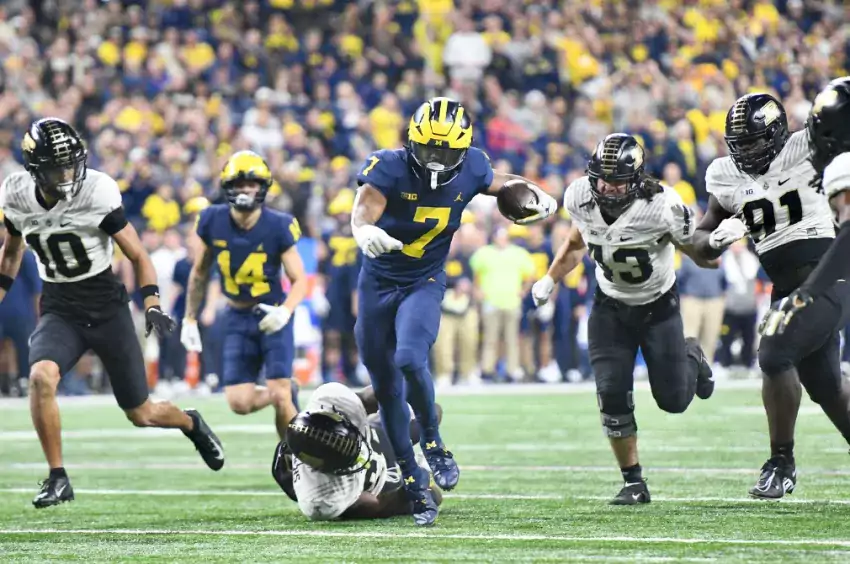
Neck Sharpies: Find the Free Hitter

Purdue had an interesting approach to Michigan's running game. Rather than throw bodies at the problem like Illinois, or throw bodies at the problem and get their asses handed to them for the second year in a row except this time at home like Ohio State, Purdue decided to take a mixed approach: add an extra hitter, but try to disguise where he was going to be.
Here's the part you may have noticed: Often before the snap, the Purdue DTs were quickly shifting their fronts. One of the purposes of this was to try to draw a false start (they didn't). But there was more to it than that. The Boilers were trying to disguise their attacks so Michigan wouldn't be able to pick out oddities before the snap and adjust their schemes to take advantage of them. Let me show you.
This is a run in the 2nd Quarter that got stuffed because Michigan set up for one blocking scheme and then didn't adjust on the fly when Purdue shifted the line late.
Power runs are brutal to observe on film so we'll go to my standardized color scheme:
- Purple: Blockdowns.
- Orange: Kickout.
- Green: Lead blocker.
- Blue: Running back, free hitter(s).
Here's what Michigan thinks they're getting before the shift.
Zooming in on the point of attack, Michigan wants to block down to the WLB, sealing both DTs with their guards, while kicking out the edge with their center and swinging Loveland around as a lead blocker. The hope with Counter is always that the defense will see your running back start moving to the opposite side and start shifting that way, creating a wider gap to run through.
Even before the snap however, Purdue does the opposite. Here's what Michigan really gets:
The only difference is the DTs moved over. Don't bother trying to parse out where everybody's going. Just look at the mess they've made of the point of attack. How're we supposed to run through that?
[After the JUMP: Another angle]
Kindly, Fox had a replay of this one so we could try to figure it out.
They come to this replay *after* the DTs have shifted to (our) left. Note what it's done to both of the guards. They're supposed to be blocking *down* on those two DTs.
The blocking plan isn't going to work unless they make an adjustment, or Purdue has those guys slant back to where they were before. Now, on the backside, Zinter recognizes this and becomes a puller just to get around this guy.
Problem solved, at least on the backside. On the frontside pulling isn't really an option. Ideally Hayes and Keegan can combo through that DT and still get to that WLB, #37, on the right (the MLB, #20, is not their concern—he is to be left for Loveland to block when he arrives to lead through the gap). That looks like it's going to come off at first. The DT off the snap is essentially even with Keegan, and Hayes is in position to give that guy a pop and move down to the WLB. That's what it feels like is happening up to this point.
But then the DT, #58, fights his way through Keegan just as the WLB hops over towards the point of attack. Now we've got a problem.
#58 has gotten through the blockdowns. He's now standing in the gap with Keegan behind him. Hayes and Keegs might try to switch dudes at this point but Keegan doesn't really have an angle on the WLB anymore—that's why Michigan was trying to get to that guy with a tackle in the first place. Also there's a someone new in the box.
And that DT makes the tackle.
So what happened? Simply enough, Purdue hopped their tackles over at the last second, after Michigan's blocking was set. This could have been dealt with by the OL making a play—get Keegan in position and have Hayes blast that DT until he's in a spot where Keegan can control him before Hayes moves down to the WLB. That's a big ask, a big play, but it's doable.
Another question we might ask however is what was Purdue giving up by flipping their DTs a gap over? Wasn't that going to leave a cutback lane or something to hit? Could Michigan have an adjustment for that? Well yeah, and in fact Michigan hit them just a few minutes earlier. On this play Purdue shifted late to the frontside, which was unfortunately once again the side Michigan wanted to run to.
This time we're going to watch what happens to Hayes, because he's the one put in a bad position by this.
The rest of this is workable, but how is Hayes supposed to get a downblock on that guy?
Answer? He doesn't.
But Ron English was being crafty, showing different looks to make his defense a harder target to hit. With #21 sticking with Ronnie Bell, Purdue's box above was a lot lighter than usual, and Edwards was able to get down to the safety.
But remember I said they weren't going full-on-balls against the run like Illinois and Ohio State, but they were adding an extra guy to the box? Well, going back to our first play, that's this guy:
That's Jalen Graham, Purdue's hybrid space player. That gap he's in was what was left open when the two DTs shifted over. He has left the FS and cornerback to fend for themselves to replace the space left by the rest of the front concentrating on the gap Michigan likes to run to. If Michigan did try a cutback, they're dealing with him at the line of scrimmage.
RPOs and short passes underneath the soft CB over there would take care of that Nickel in a modern spread, at least long enough that he can't bother the running game. The difference between the run that the DT stuffed and the one where Michigan was able to create the lane on the backside was that WLB. In the first play, he's shuffling over, getting into Hayes as soon as he can. The reason he can do that is a cutback lane is getting closed off by the hybrid (N) instead. On our second play, the WLB had to be the guy babysitting a cutback himself, and got sealed by Keegan.
So that was Purdue's game most of the day: adding a guy to the box late and shifting fronts around so Michigan's blockers would have a tough time getting their preferred lanes blocked up correctly. Sometimes they were shifting linemen late, other times they were blitzing their LBs into interior gaps to become de facto DTs. There were still ways to defeat it, and Michigan did indeed manage to get it blocked up quite often. But the strategy proved successful for much of the game, since defeating the front often just delivered the running back to that free hitter. Michigan was forced to use a bunch of play-action passing to take advantage of the secondary that Purdue was borrowing extra material from. JJ was up for it, but that was a fair gamble to take for Purdue.
But Michigan found another way of dealing with it. Remember, you can defeat anything in football three ways:
- Play assignment football: Have so many checks and adjustments, and execute them so perfectly that you can turn any look into what you want it to be. This would be Hayes and Keegan comboing through the DT to the WLB anyways, or planting the DT outside and moving the gap they attack inside by one.
- Call something that takes advantage of where they're weak. Like play-action with a pass where the HSP or safety just came from.
- Make a play.
These are not mutually exclusive strategies. Sometimes, for example, you can call a play that delivers your back to that extra defender in space, and then watch him burn. The one super long run by Edwards was delivering him to a cornerback tasked with edge defense, but that one was so obvious you don't need to see it again. This one…this one was special.
Here you can see an example of the blitzing, as the WLB is coming right for the Zinter/Barnhart gap at the snap. Barnhart blows him out, but there's a DT in the next gap and Zinter can't get that guy planted under Olu before Barnhart has to move on, so that blitzer ends up about as free as DT #58 in our first example.
Once again, Purdue has delivered a free hitter to the box to make up for aggressively attacking what they thought would be the frontside. The difference this time is there's a little more space in the gap because JJ was threatening to keep the ball on an Arc Read. Loveland saw #96 get so far outside and kicked him for JJ's handoff read. Now Edwards and the HSP have a nice big gap all to themselves. The thing is, Edwards is a much better football player than #6.
So that would be a #3.
December 7th, 2022 at 10:43 AM ^
I know how Purdue felt on That Edwards Run (TM). It gave me Amir Pinnix PTSD flashbacks.
December 7th, 2022 at 11:05 AM ^
Small sample size since I'm going off the Neck Sharpie itself, but it seemed to me that timing the snap made a significant difference. On the stuffed run, the shift came immediately before the snap -- the O-line was flat-footed and had to improvise. (Which mind you they are really good at, but they stuck to their doomed assignments.)
On the second clip, the shift came a few seconds before the snap. You can't move once you're set but I figure Olu is still allowed to yell, and that interval would've given him enough time to audible the call.
Since the offense controls the snap, I speculate it was relatively easy to adjust once they saw what Purdue was doing. They still had +1 in the box, but I doubt the line shifts were doing much damage as the game went on.
December 7th, 2022 at 12:19 PM ^
This is the second consecutive game where the defense has done something that haven't been putting on tape. You know when you're forcing teams into gameplan gimmicks you have a good offense.
And, once the gimmick is figured out...well, the results speak for themselves.
December 7th, 2022 at 4:02 PM ^
I made a comment in the game thread, something like "if they're running trick plays and breaking out the fake punts in the first quarter, that bodes well for us."
Reminded me of the Rudock Florida game. Florida used a trick play to score their first TD, and after the game the players had some quotes like, "if that's how they have to score, we got them."
December 7th, 2022 at 11:20 AM ^
first example had proper assignment and shift 'on the fly' adjustments by the O-line. problem was that 58, to his credit, beat his block. otherwise, we have a hat for every boilermaker at the point of attack. our O-line is wicked good.
December 7th, 2022 at 12:13 PM ^
#58 was lined up to win the block. It would've been hard, as Seth said, for the offense to win that back and it looked to me like it almost worked.
That's saying something. If the alignment has the blocking dead to rights and the play almost works anyway, that's pressure on the DC. The resources defenses are forced to invest to bottle up the run game opens up other things, and Michigan's feasting.
December 7th, 2022 at 11:56 AM ^
There's an answer that needs more attention and may be required against Georgia, perhaps even TCU: use JJ in the running game.
No one is being optioned on these plays and JJ is not really making a keep/pull decision. If you option a player instead of blocking him, that's one more body to take on the free hitter or deal with the shift.
We didn't need to risk JJ in this game, but the playoffs will likely be more demanding, especially if we get to Georgia's defense. Jalen Carter alone will make runs between the tackles tricky.
While I love our gap schemes, we need to add the threat of the QB run to even up the numbers against better competition. We've shown we're willing to do that, and against OSU and PSU it helped us spring big plays.
Can't wait to see the approach in the playoffs!
December 7th, 2022 at 2:23 PM ^
I imagine there are less options because with Edwards playing with one hand the mesh point becomes dangerous.
December 7th, 2022 at 12:47 PM ^
I envision TCU downloading the D plans of M's last 3 opponents and mimicking it. And I envision M playing as if their Jimmies and Joes will win the day so they can save all the frippery for Jan 9, if possible.
December 7th, 2022 at 1:25 PM ^
Here's what Michigan thinks they're getting before the shift.
Question from a noob: Are there line calls that are made after everyone's set that changes who's pulling? This is the illustration from before the Purdue defensive line adjusts, and just looking at the down blockers, it seems like it would make more sense for Oluwatimi (#55) to down block that DT than Zinter (#65), simply based on the angle. (It became even easier for Oluwatimi to make that block instead of Zinter after the defensive line shifted, but that's besides the point.) Do offensive linemen ever have a call before the snap that switches their assignments because of how the defense sets up? In this case, it would make Zinter the puller, but keep the rest of the play completely the same.
December 7th, 2022 at 1:39 PM ^
yes re: line calls are made by all across the front. quick shift by D-line and the O-line will yell those things, one-word calls. its tough in real-time on a very quick D-line 'stem' (the action of the D-line moving prior to the snap) right before the actual snap, but our guys blocked it about as well as could be asked of them. they are super-talented and well coached. we are blessed.
EDIT: i'll add some of the more common phrases are things like 'gap', 'beef', 'combo', 'opposite', 'charlie', 'tango', etc.
December 7th, 2022 at 2:03 PM ^
What Purdue is doing is called "stemming" pre-snap. Switching from an under to over front right before the snap. Georgia does it a lot (more in and out of Odd fronts, but similar idea). It has a few impacts: who pulls; how you anticipate your front side combo block; and maybe some front side tags.
With the combo block, you have your 1st level target to 2nd level target (DT to backside LB). The timing and how you come off the block is based on clues of the alignment, because it can hint at line slants or LB games, etc. Sometimes you'll be very patient at the first level and really dominate the double team before releasing, sometime you have to work quick. You should do this based on post-snap response too, but having pre-snap clues allows you to do it more effectively. Stemming the DTs is a way of changing those clues without giving time to process it.
On counter, Michigan pulls either the C or the backside G (BSG) depending on the defensive alignment. When the DTs shift, they nominally would have had the C block back on the A-Gap NT and pulled the BSG. I'm not convinced Zinter wasn't trying to make this adjustment, saw Olu still pulling, and basically turned his pull into a cut off block (on the first play). Olu blocking back on an A gap defender is much easier than Zinter reaching and hinging. A block back here keeps that DT in the backside A gap and allows the RB to punch it vertical.
The front side tag is a little more game plan dependent (Michigan did both last year), but it has to do with the TE block. With the DE aligned inside, he can block down on him or he can arch to the first defender outside the formation (CB here). Don't know for sure here, but generally, big-on-big (OL on DL) is nice, the arc allows for that. But, when the DL stems presnap, they get a defender in the C and B gap, instead of the C and A gap. The major difference: it's a lot easier to widen a C and A gap for the wrapper and RB than it is C and B gap, so Michigan may have preferred to block down with the TE on the DE and allowed the puller to wrap to the CB. In general though, the C and B gap covered by DL is very hard on inside gap schemes.
On film, I thought UM was going to run more gap schemes. This may have been why they didn't. Stemming isn't specific to gap schemes (it has benefits vs zone schemes as well), but in general, it's easier to adapt zone blocking for it than it is gap.
December 7th, 2022 at 11:42 PM ^
Your third sentence is exactly what many are wondering. Well...maybe just me. I didn't mean to pull a Trump (many people, many many many many, are wondering, they really are).
December 7th, 2022 at 5:14 PM ^
I suppose this would partially fall under #2 on "what you can do", but it was brought up in another thread about how awesome it would be if the staff developed audible calls for JJ. That would of course take time to install -- but even the threat of an audible might curb this late-shifting some.
That is, the defense shifts and JJ yells "kill, kill, kill", making the D wonder if something completely different is coming at them. Even if there's no real audible play-change, this bluff might work in key situations......
Now if there were real audibles, that might be amazing. Oh, you're rolling up a safety to make 8 in the box.....ok, a long pass against man coverage.
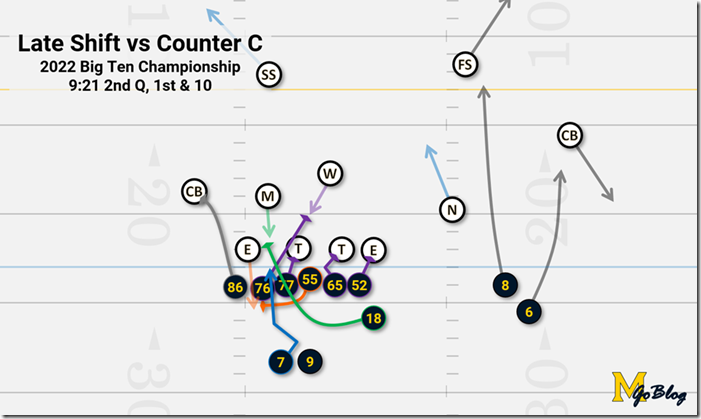

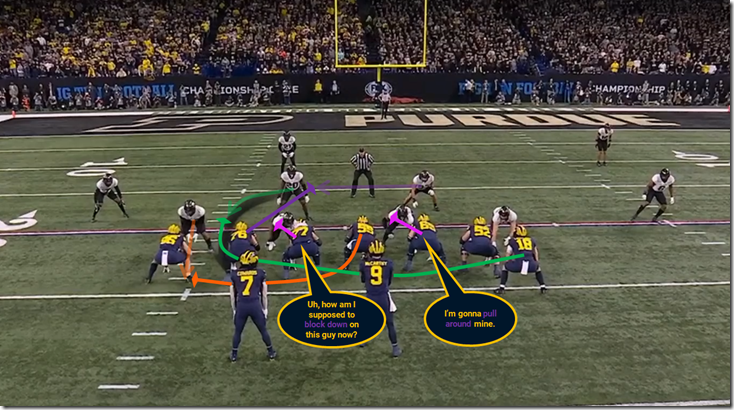

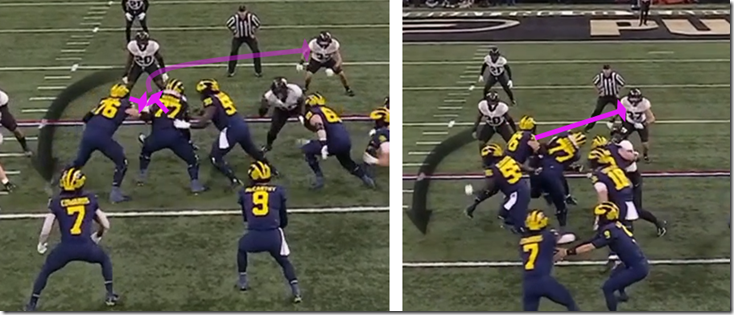
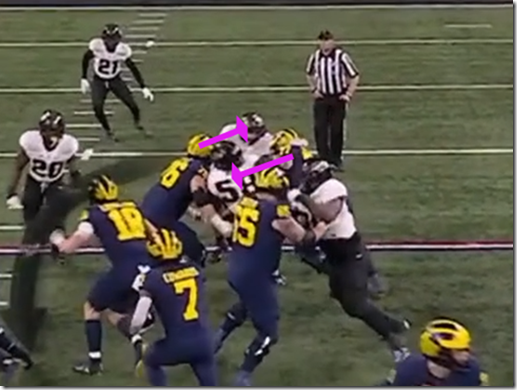
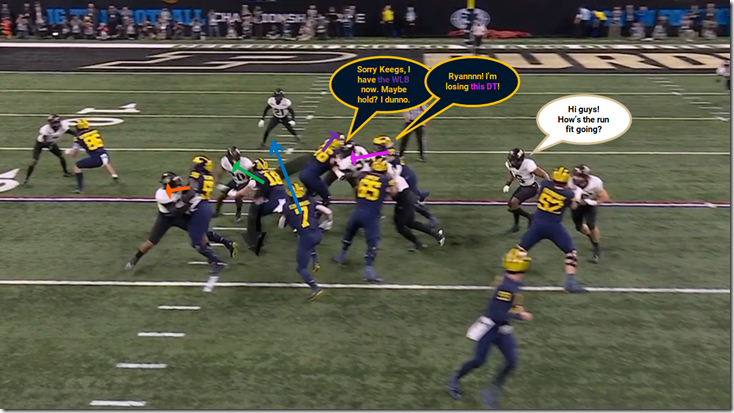
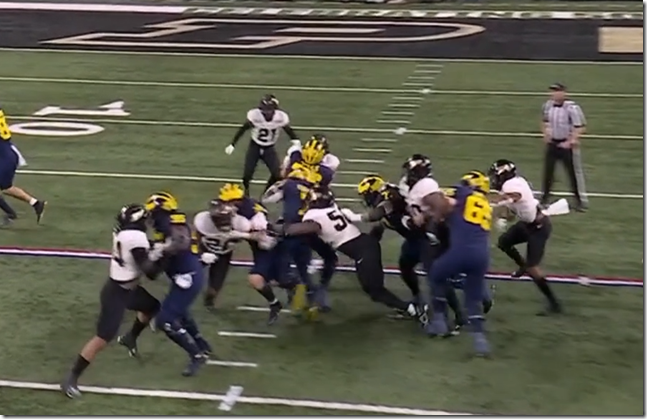
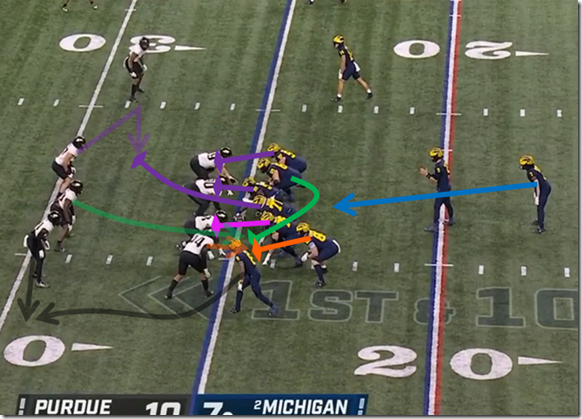
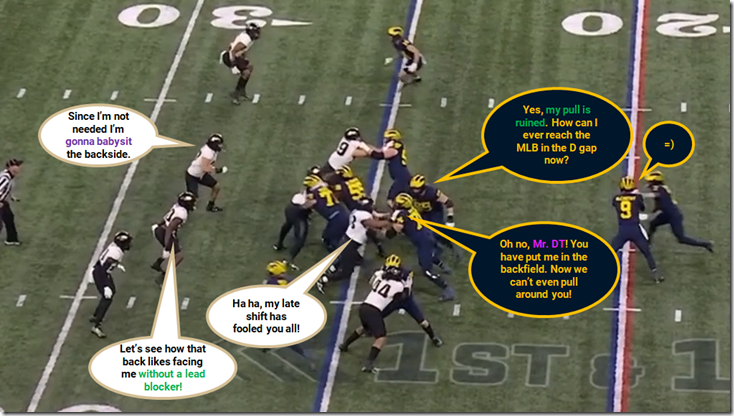
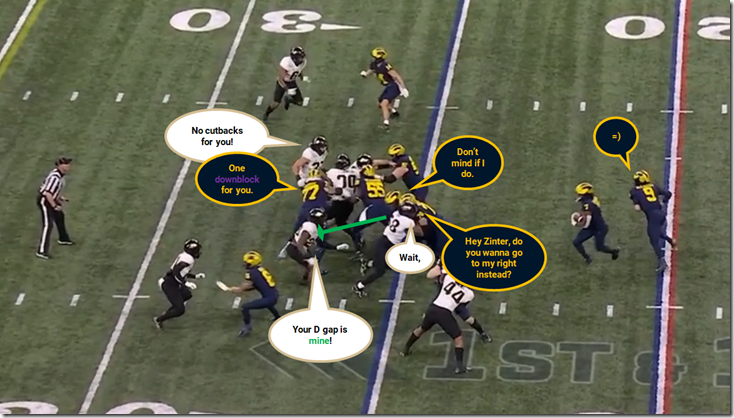
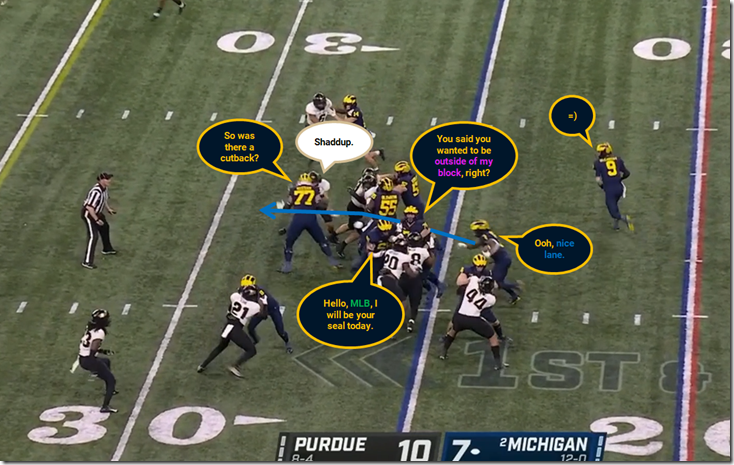
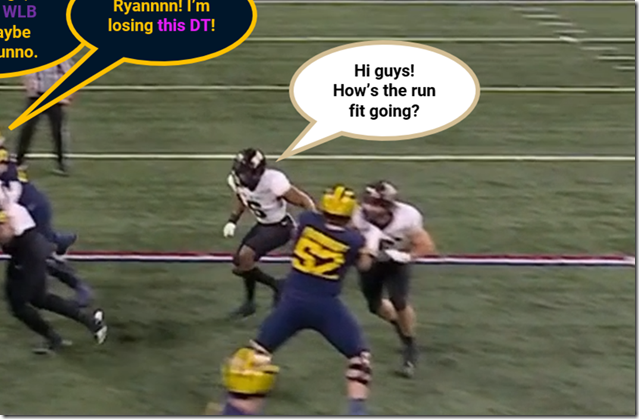
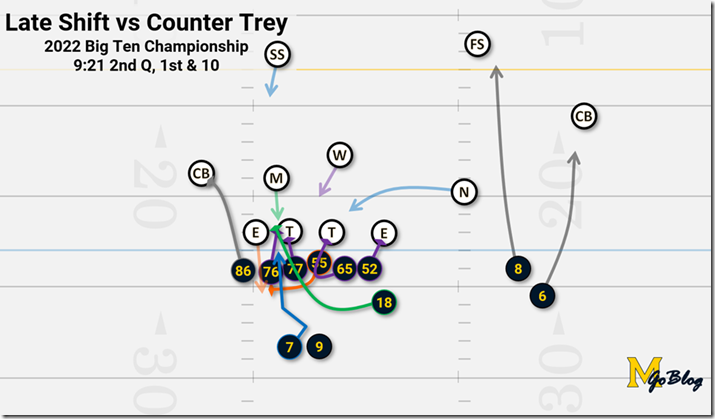
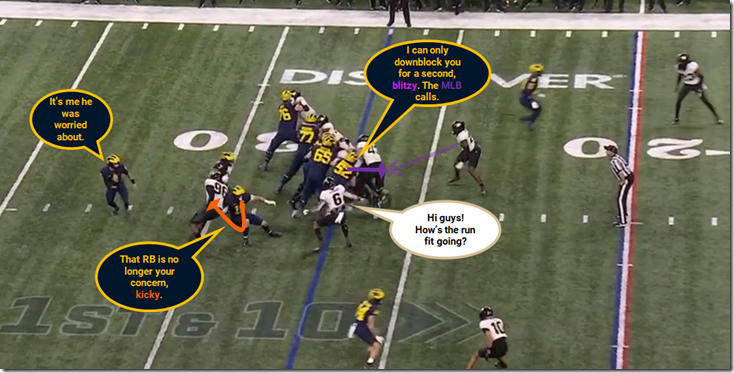
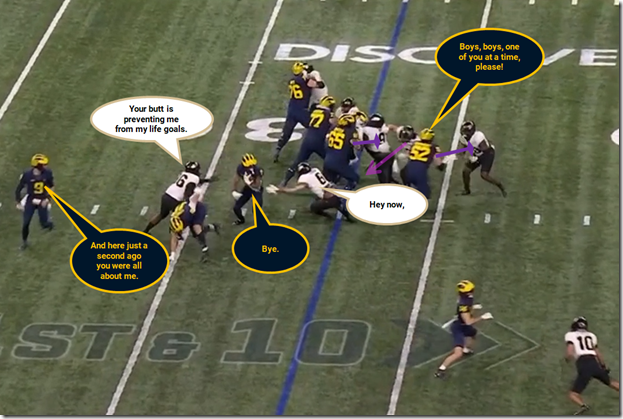
Comments